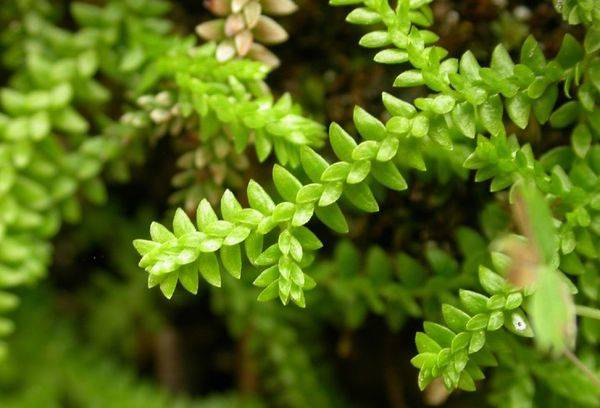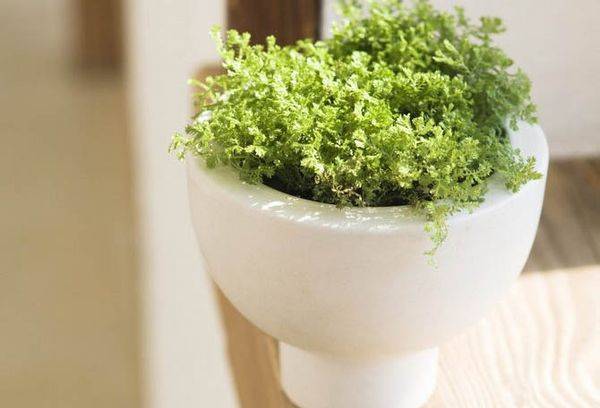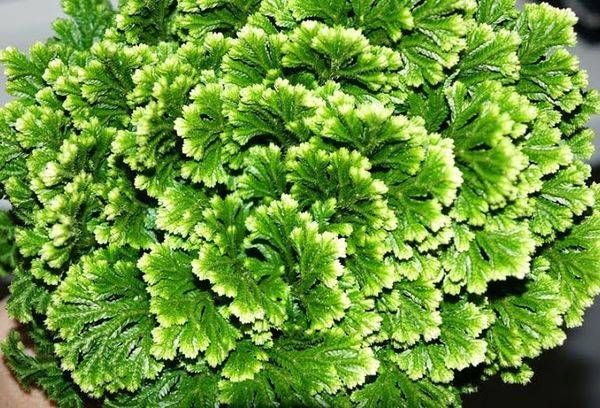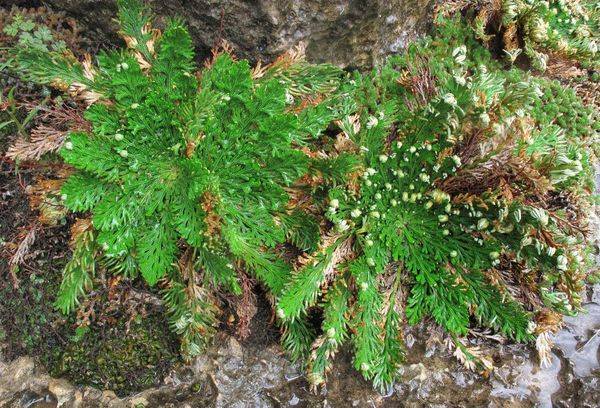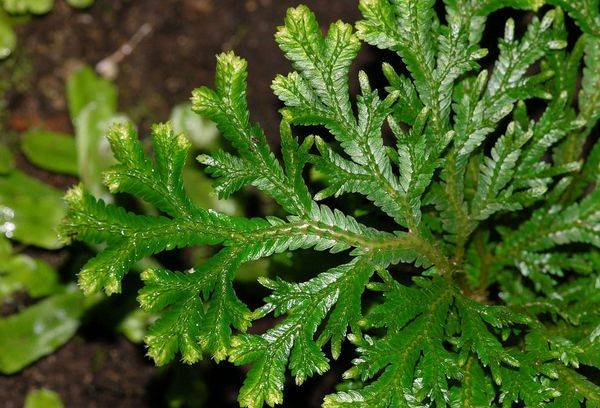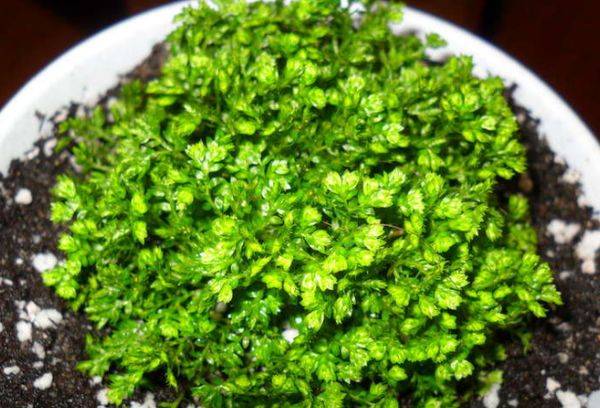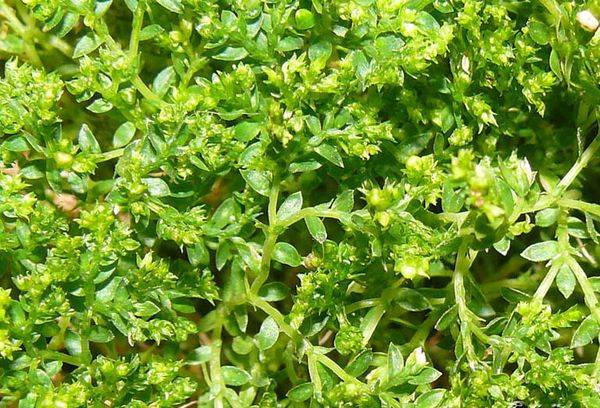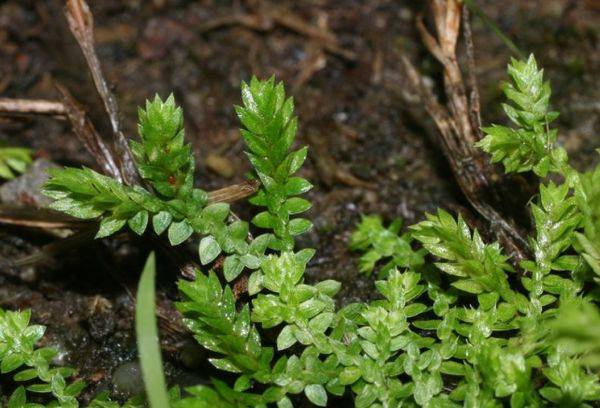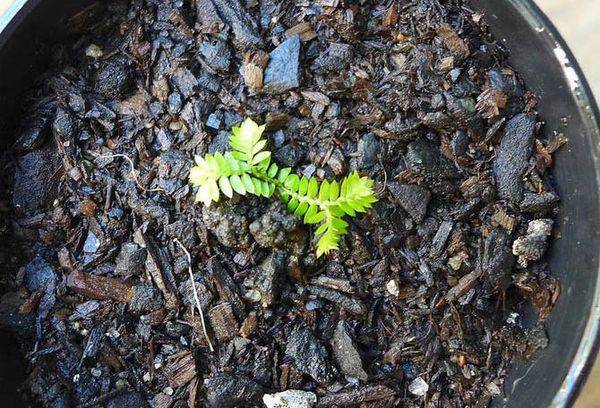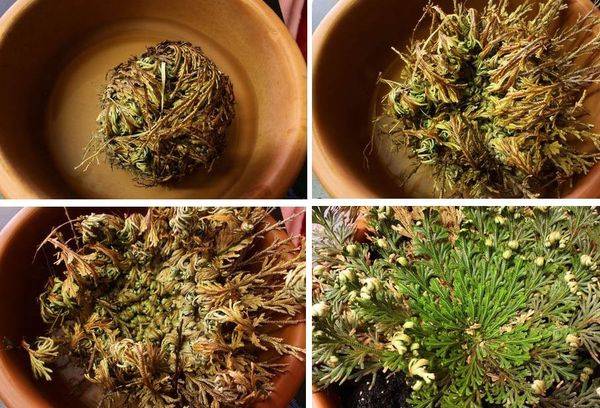Rules for the care and reproduction of selaginella
Content:
Selaginella in appearance resembles moss and fern, as it is a herbaceous perennial groundcover. Openwork small leaves look very bright and beautiful, because many flower growers have fallen in love. At the same time, the selaginella is capricious, and careful care is required, otherwise it is unlikely to admire the attractive appearance of the plant.
Description
Selaginella belongs neither to ferns nor to deciduous plants, although it bears a resemblance to them, and belongs to the family Plauchnikov and is a grassy spore plant, one of a kind.
Terrestrial and epiphytic forms that occur in the family with creeping or rising shoots have many thin root processes. Branches, branched and rather short, are covered with very small leaves, only 5 mm long. Thanks to them, the plant has an openwork shape, the shoots are covered with leaves like scales.
Coloring of leaflets can be of various shades - from light green to dark green; species with leaflets of a bluish or metallic shade are rarely found. Sometimes the branches of selaginella end in small spikelets, where several large or many small spores mature.
Selaginella does not bloom, its beauty is due to bright greenery, but the plant has an attractive appearance only with proper care. The family of selaginella includes approximately 300 species; only 25 are bred as ornamental and indoor plants.
Indoor Views
The most common in potted floriculture are the following types of selaginella:
- Jory. It is small in size, has erect shoots that are painted in light green, with a golden fringing at the edges of the leaves.
- Scaly. It has an unusual shape, in appearance resembling a large flower, due to which the species received another name - Rose of Jericho. Shoots grow on average 10-15 cm long, in the dry period they twist together with the leaves inside, thus forming a ball. On sale, selaginella scaly is often exhibited in the form of a ball of absolutely lifeless-looking dry grass. As soon as such a lump enters the water, it comes to life within a day, blooms with fluffy branches, and becomes saturated green.
- Martens. It is a stunted bushes, covering the soil with a dense carpet. In appearance they resemble moss. The stems are erect, up to 20 cm high. The flower perfectly develops with sufficient humidity and diffused light. Most often, the view is used to create small greenhouses.
- Legless It has the appearance of decorative grass with short stems, which are densely covered with very small tender leaves. With optimal care (air humidity and watering) forms a soft fluffy carpet on the surface of the soil.
Home Care
A common problem when growing selaginella at home is insufficient moisture. For this reason, the plant feels most comfortable in a greenhouse.
How to care for selaginella:
Lighting. Selaginella will develop equally well in bright natural light and artificial light. The flower does not belong to shade-tolerant and feels uncomfortable in a deep shadow, but it grows excellently in light partial shade and in bright diffused light. The plant must be protected from direct sunlight.The main advantage of selaginella is that they tolerate fluctuations in illumination, so there is no need for additional illumination in the winter months.
Tip
Place the flower on the windowsill of a window facing north or in the back of the room.
Temperature. For most types of selaginella, the temperature regime in the range from +15 to + 21 ° C is ideally suited. Darkening and dying of leaves indicate an unsuitable temperature for growing a flower. In addition, selaginella do not tolerate drafts. Heat and too low temperature are bad for the appearance of the plant. Below + 12 ° the thermometer in the room where the selaginella is located should not fall, as the plant will die.
Tip
Do not take the plant out of the room to fresh air.
Air humidity. Under natural conditions, selaginella grows in ordinary soil, on swampy soil and with excessive moisture, can tolerate even complete immersion in water. Humidity in the room where the flower is grown should be approximately 70-80%, at least 60%. To maintain the optimal value, spray the plant 4-5 times during the day, place saucers next to it with water or wet expanded clay.
Tip
purityis.decorexpro.com/en/ magazine draws your attention: the higher the humidity in the room, the better ventilation should be.
In the winter months, place the flowerpot with the plant at the maximum distance from radiators and radiators. The peculiarity of selaginella is that at home growing it practically loses its ability to adapt to conditions with different humidity.
Watering. Selaginella needs a generous watering, regardless of the time of year. The earthen coma should not be allowed to dry out; the soil should always be slightly moist. Water the plant with soft, settled water at room temperature through a drip tray. In this case, the soil will absorb as much moisture as necessary.
Top dressing. Twice a month or every 3 weeks from April to September, the flower must be fed. For these purposes, a complex fertilizer intended for deciduous houseplants is quite suitable. In winter, feed less often - no more than once every 6 weeks.
Use half of the dose recommended on the package, and it is better to take 3 parts of water for 1 part of the fertilizer (for winter feeding, the proportions should be 1 to 4). Fertilizers designed for orchids are ideal for nourishing selaginella.
Priming. The soil mixture in which selaginella will be grown should have a neutral or slightly acidic reaction, be quite loose and hold moisture well. Soil containing river sand, sheet soil and peat in equal amounts will be suitable. Before mixing peat and leafy soil, put in the freezer for several hours.
Recommended soil mixtures for growing selaginella:
- 1 part of leafy soil, 2 parts of soddy soil, 1 part of peat land, sand (it is allowed to replace it with crushed sphagnum);
- in equal proportions: turf, peat, pieces of charcoal, chopped sphagnum moss.
In the pot where selaginella is grown, a drainage layer is required, since if air does not flow to the roots, the plant will develop poorly and will most likely die.
Reproduction and transplantation
In the natural habitat, selaginella reproduce by spores. At home, a similar method is used extremely rarely even by professional flower growers. It is much easier to propagate the plant by the usual division of bushes, that is, vegetatively.
In spring or summer, part of the rhizome, approximately 5 cm long (it does not matter if it has shoots), divide and transplant into flowerpots with peat, 5 each. Before the first shoots appear, keep the pot at a constant temperature of + 20 ° C, covered with a plastic film. Sprouts will break in about a month. The soil must be kept moist at all times.
Also, selaginella is propagated by cuttings.Cut the shoots of the stems into pieces at least 3 cm long, these will be cuttings. You should choose only twigs where there are small roots on the branches.
Put the cuttings in a container on the surface of the sand-peat or pearlite-peat mixture and lightly sprinkle their ends with soil. Make a small greenhouse by wrapping the container with plastic film, this will ensure constant high humidity and temperature. Put a mini-greenhouse in a place with diffused lighting.
As soon as the shoots appear, divide the cuttings (each of the pieces must have roots) and plant in separate pots 5 pieces each. Such a landing will make it possible to obtain a voluminous beautiful bush in the future.
Selaginella does not like transplants, so it is not recommended to carry out the procedure more than once every 2 years. The main criterion for the need to transplant a plant is the root system that is completely filled in the pot. The preferred time for the procedure is the summer months.
The pot for selaginella should be wide, but not shallow, since the root system of the plant does not penetrate deep into the soil.
Diseases and Pests
Optimum growing conditions make selaginella virtually immune to pests and diseases. Violation of even one of the rules of care contributes to the appearance, most often, of a spider mite, less often - other pests that are actively developing in conditions of low humidity. To kill pests, spray the plant with soap and water.
Excess moisture leads to the appearance of rot, therefore, if the room temperature is below + 19 ° C, watering should be moderate.
Useful Tips
The recommendations of experienced gardeners will correctly identify a violation of the rules of care for the appearance of the plant and timely eliminate them:
- The tops of the shoots of selaginella become dry with insufficient humidity in the room.
- Yellowed, brown and dried shoots are evidence of excess fertilizer. In this case, the twigs are best used on cuttings and propagate the plant in this way.
- If the edge of the leaf blades has acquired a brown tint and is deformed, then the lighting for the flower is too bright. This is how sunburns appear. Just put the flowerpot in the shade. When exposed to direct sunlight, the leaves may fade and discolor.
- Strongly elongated shoots and leaves that are pale in color, twisted and too rare, indicate insufficient lighting.
- Selaginella grows very slowly with a lack of nutrients in the soil.
- Leaflets will be lethargic and very soft if not enough air enters the root system. Transplant the plant into loose soil.
- The leaves turn dark, blacken and die off if the room temperature is very high.
- Selaginella growth becomes very slow, the branches become brown and begin to rot at low temperature. Remove the damaged shoots, transplant the flower into a new flowerpot with a suitable soil mixture and place in a moist, warm place.
- The leaves are curled, curled or deformed if the selaginella is in a constant draft.
- If the soil mixture is not suitable for growing plants, too dense, then the leaves will become soft.
